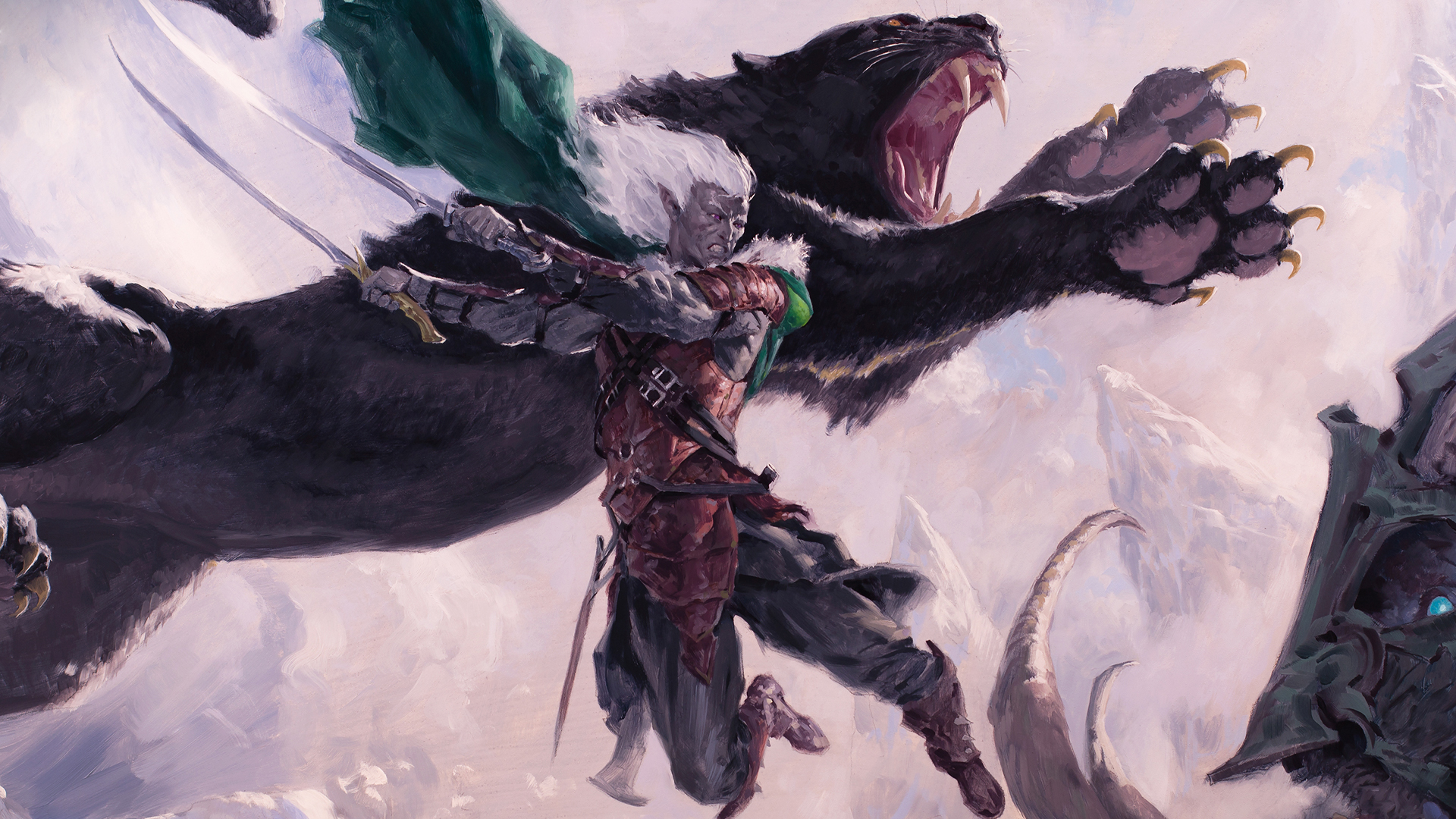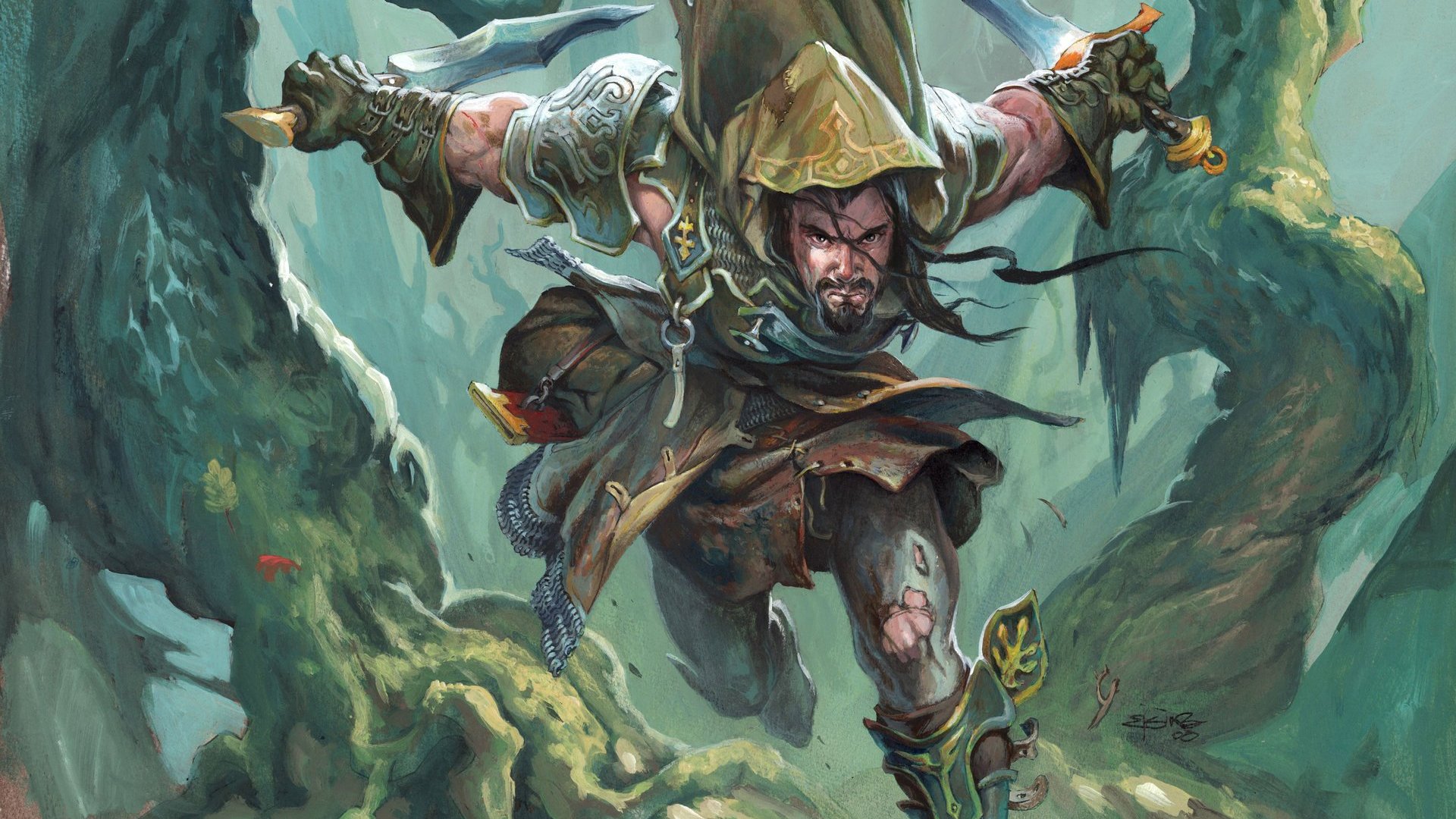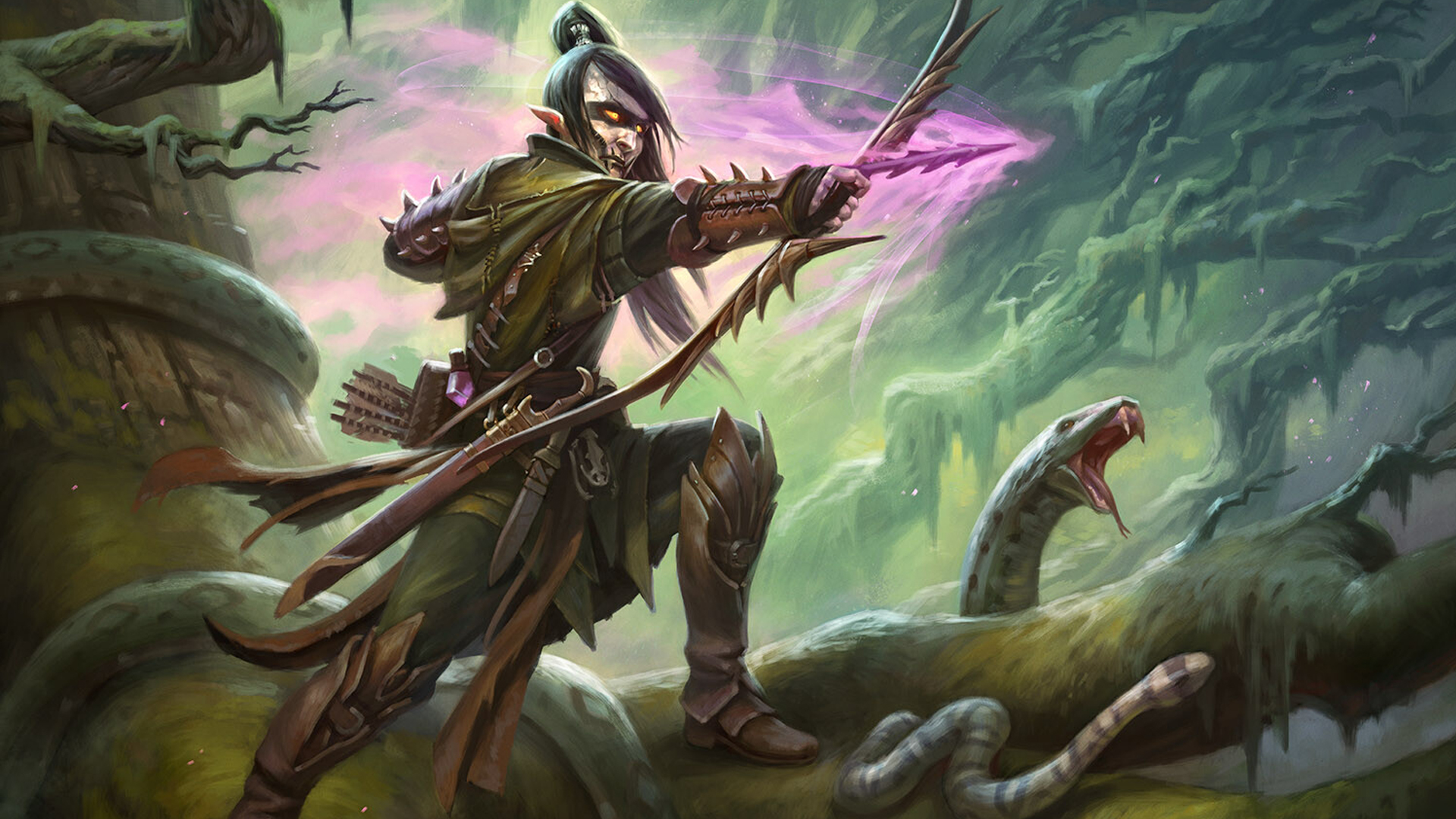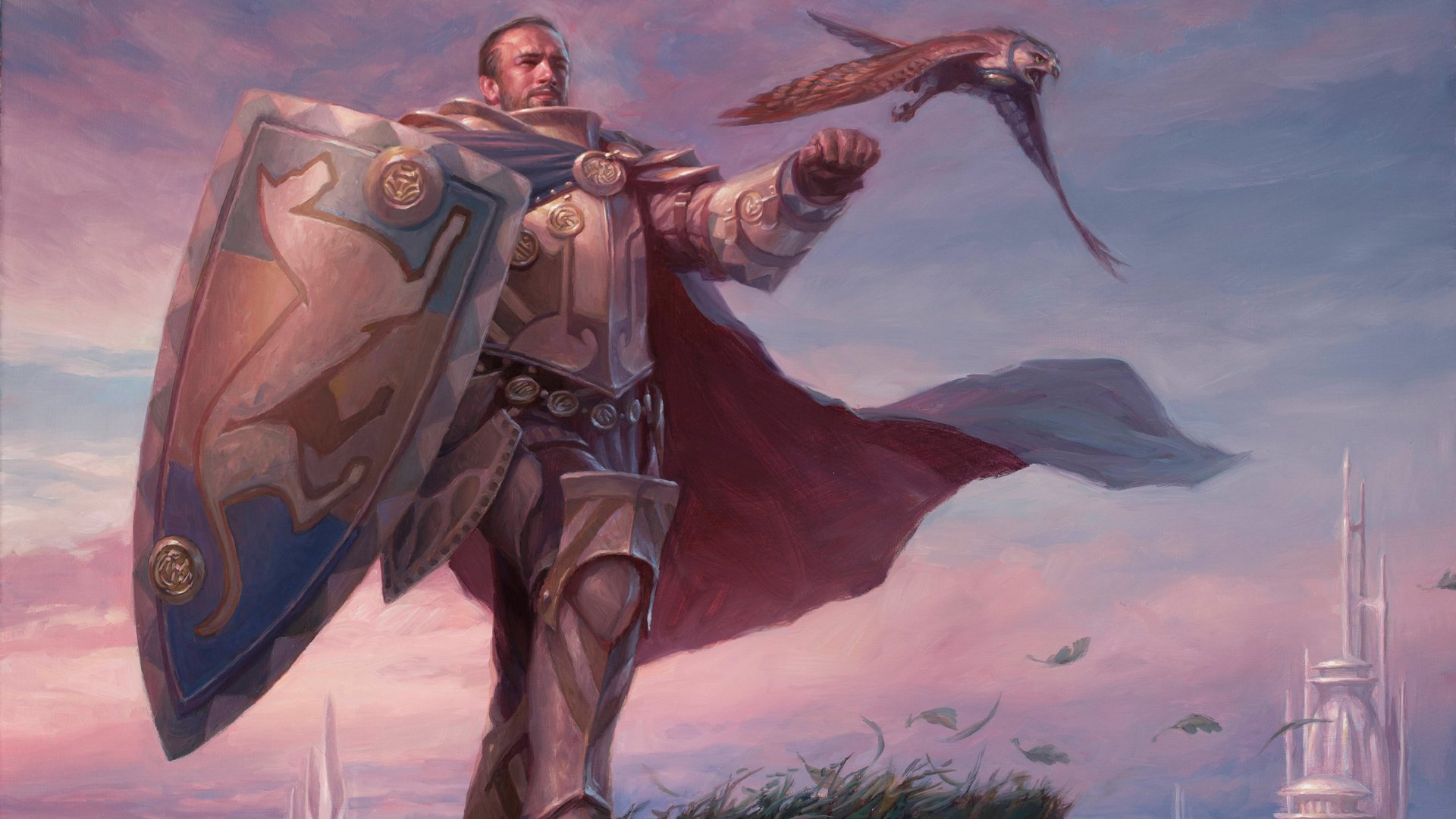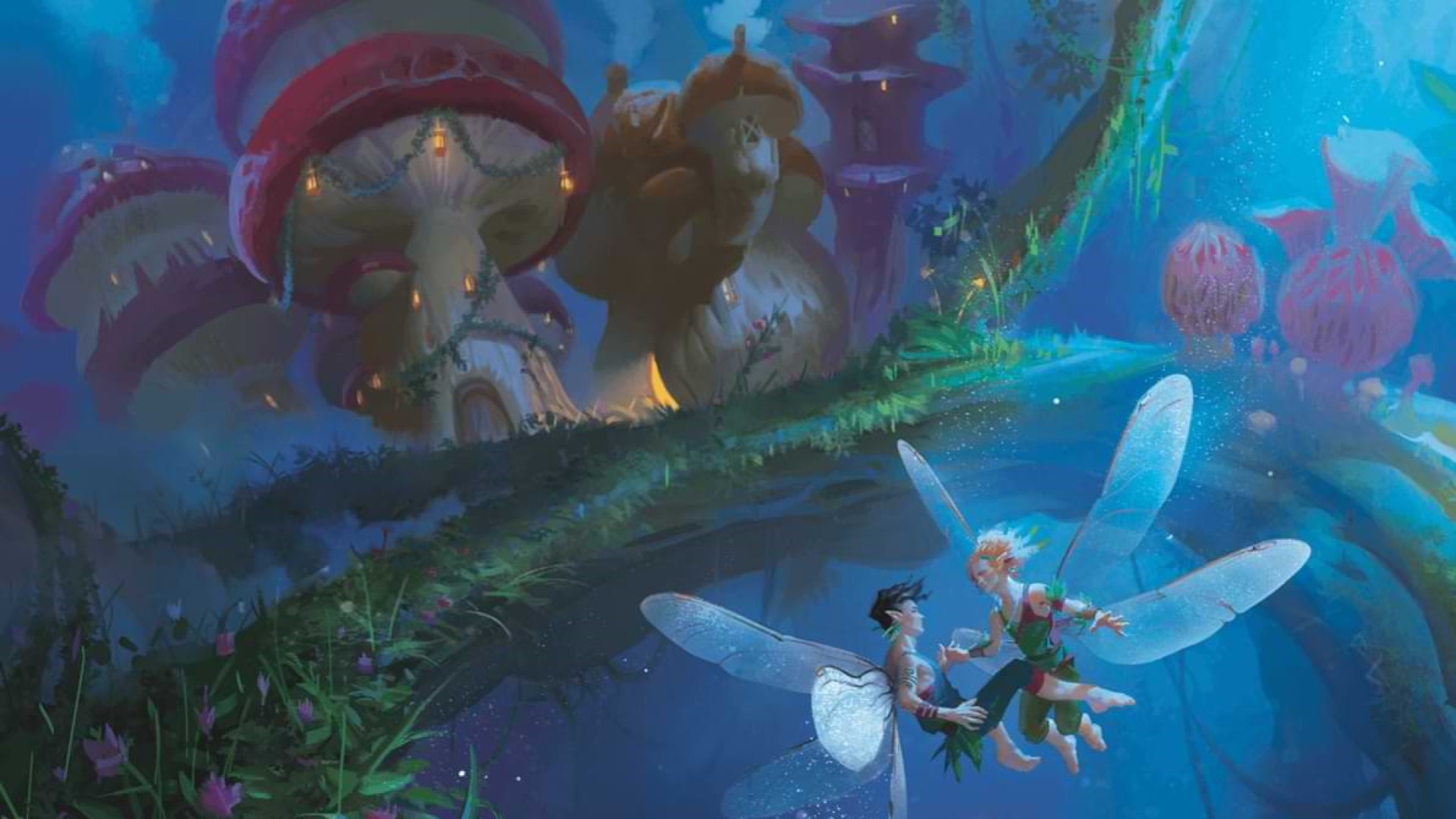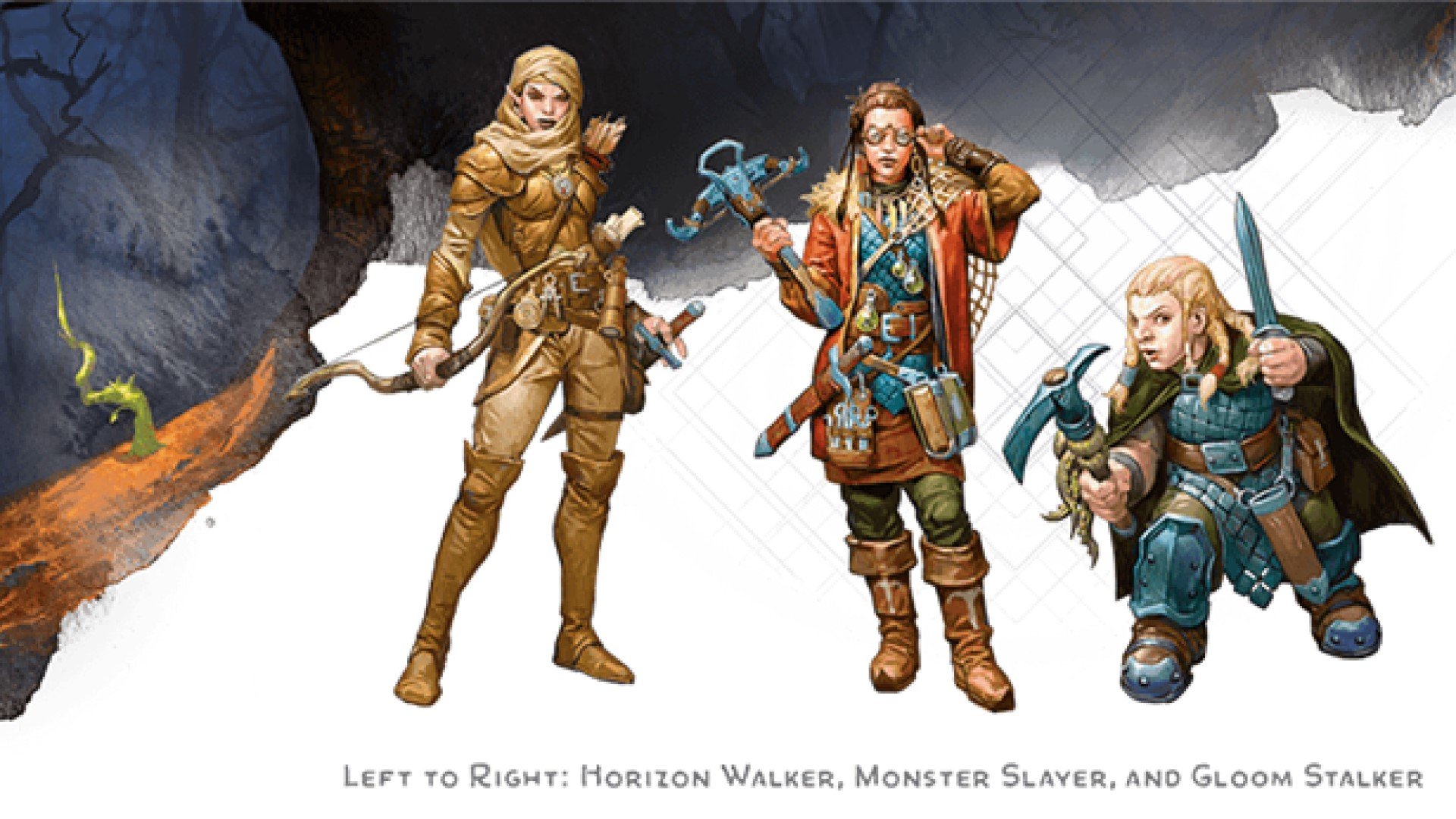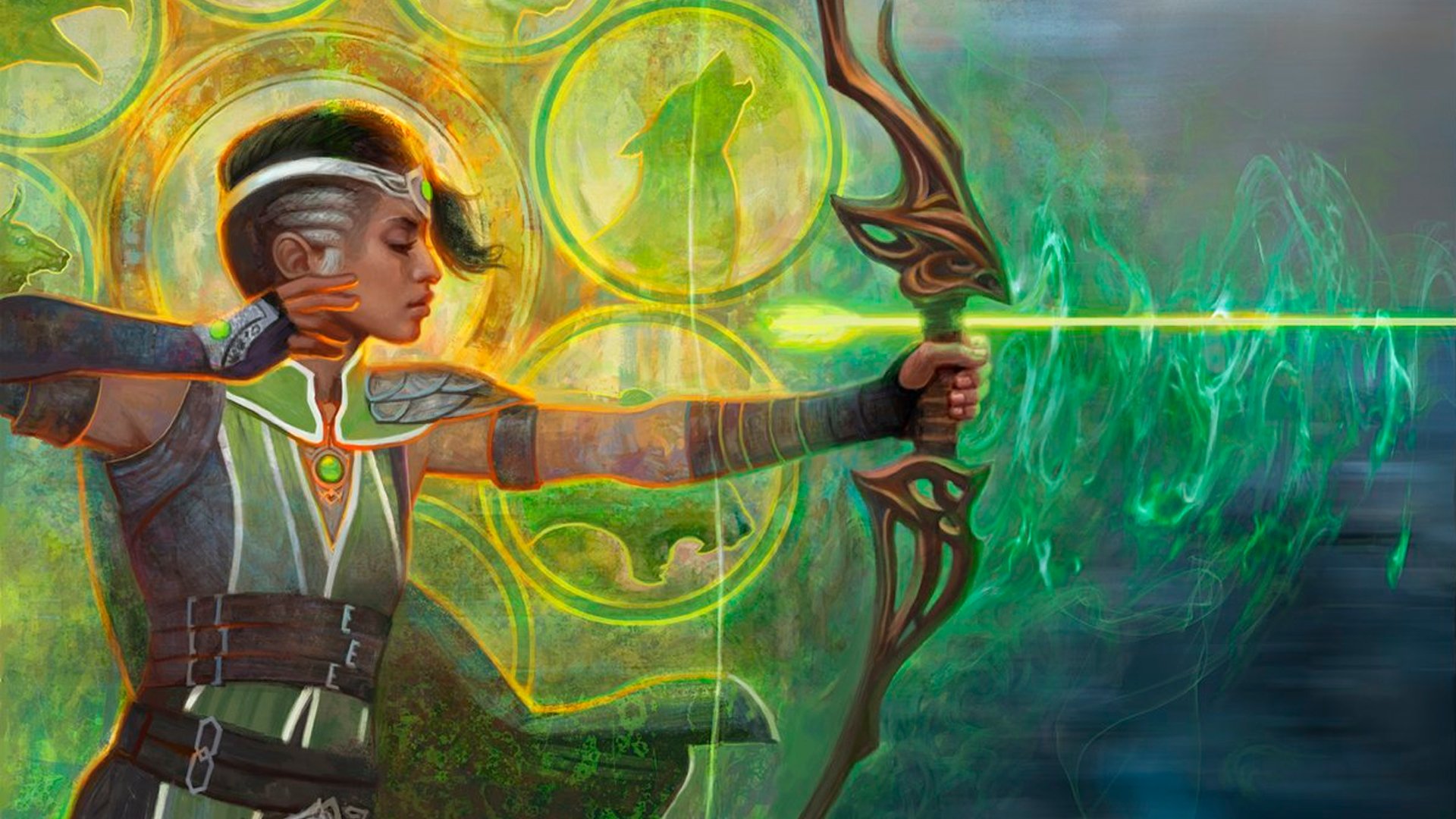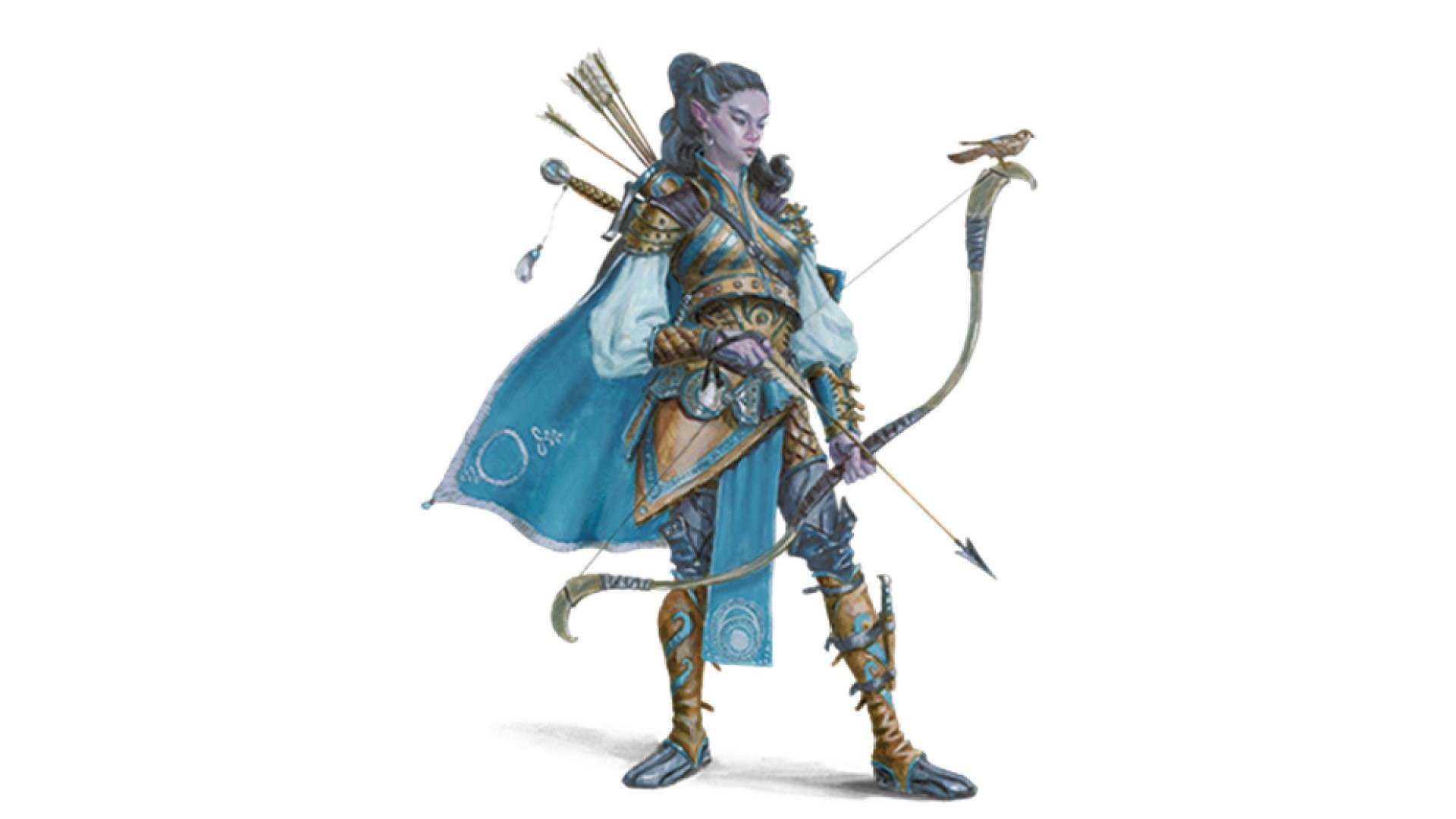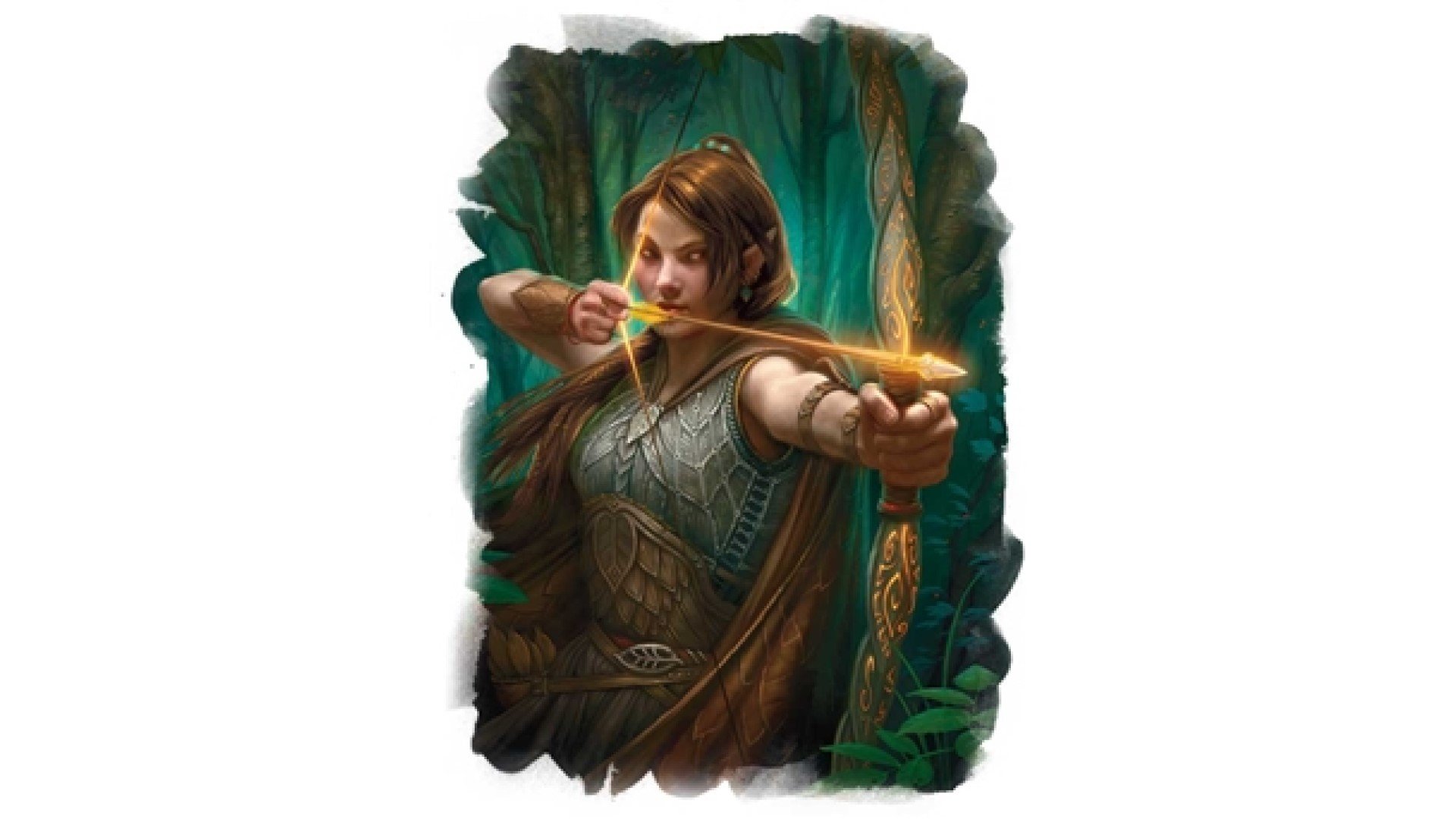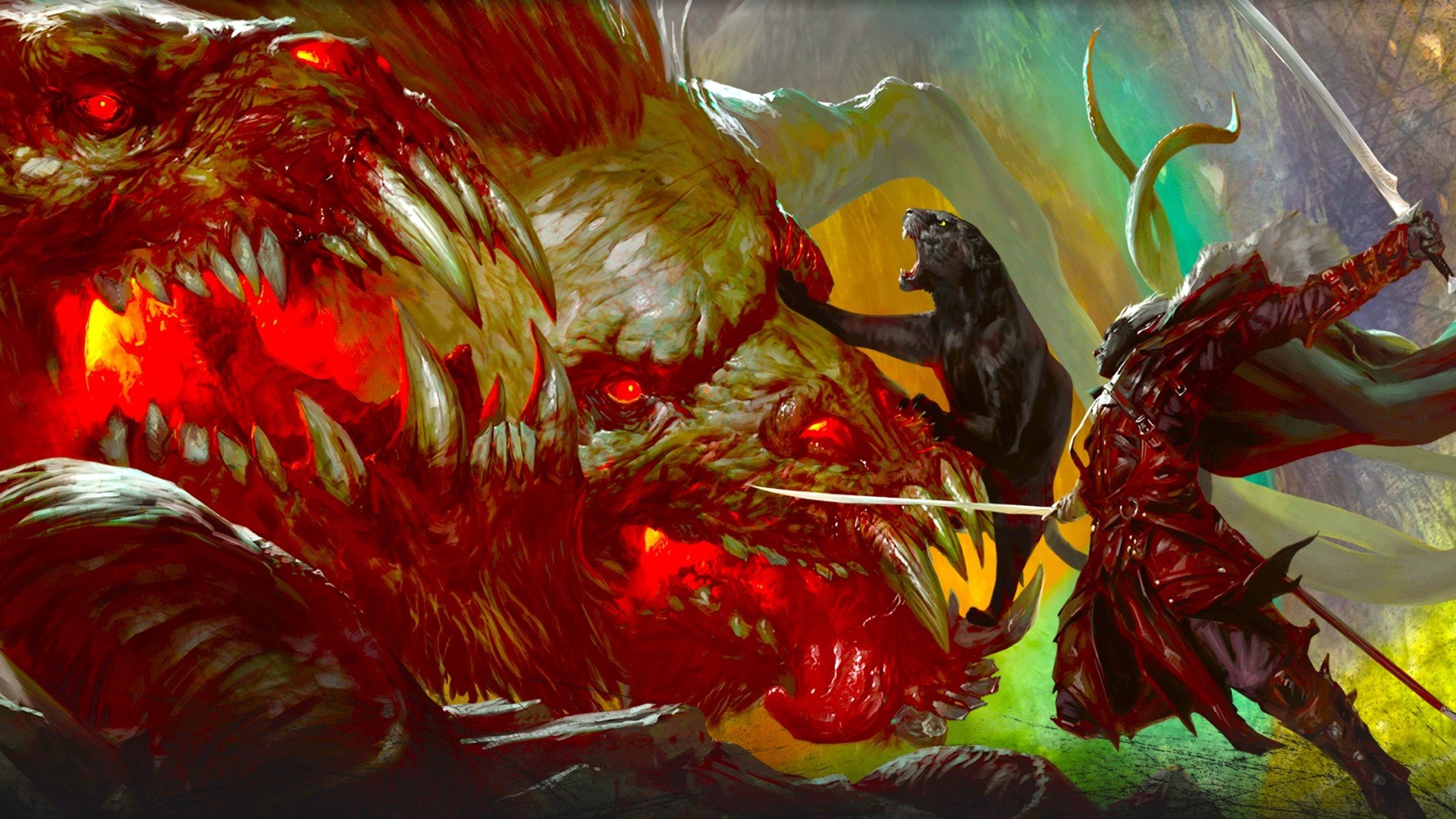Heavily inspired by J.R.R Tolkien’s Aragorn and the Rangers of the North, the DnD Ranger class was introduced in the earliest D&D books. Known for their variety of fighting styles, Rangers tend to be as skilled with a bow as they are full of deadly finesse in close combat. Our Ranger 5e class guide gives you everything you need to roll up a little Aragorn (or Drizzt Do’Urden) of your own.
Admittedly, the DnD Ranger 5e class isn’t as well regarded as some other DnD classes power-wise, but, if optimised correctly, they are a formidable aide. From a roleplaying perspective, too, the Ranger offers plenty of character progression – especially with Favoured Enemy. You can lean into this ability to create a story for your character, fleshing out the dark origins of your searing hate for DnD Goblins, and so forth.
Below you’ll find all the info you need for Ranger character creation, including the best DnD races to choose, Ranger subclasses, and strong beginner DnD character builds to give you a solid start on your next adventure. We also recommend skimming our DnD character sheets and free online DnD character creator tools, to make the creation process a breeze.
Here’s what you need to build a Ranger 5e DnD character:
Ranger 5e stats
| Hit dice | 1d10 per Ranger level |
| HP at lvl up | 1d10 (or 6) + your Constitution modifier |
| Primary ability scores | Dexterity, Wisdom, Constitution |
| Armour proficiency | Light armour, medium armour, shields |
| Weapon proficiency | Simple weapons, martial weapons |
| Tool proficiency | None |
| Saving throws | Strength and Dexterity |
Regardless of whether you’re looking to focus on ranged or close combat, concentrate on Dexterity (Dex) as your primary attribute. Even in melee, you can use Dex as a primary statistic on any weapon that comes with the ‘finesse’ quality.
Crucially, Dex is the primary statistic for ranged combat, naturally one of the biggest draws to playing as a Ranger. Maintaining a high Dex statistic also supports Acrobatics, Armour Class, and even Stealth – which is another speciality for the class. Basically, you want Dex to be your main focus if you intend to play the class to its fullest potential.
Starting at level two, Rangers can cast spells with their casting attribute in Wisdom (Wis), so this should be your secondary focus, with Strength (Str) and Intelligence (Int) being your dump statistics. At level one, you have significant experience in studying, tracking, hunting, and even talking to a certain type of enemy.
You also get to choose a type of Favoured Enemy, which grants you an advantage on Wis (Survival) to track them, as well as Intelligence (Int) to recall information about them. It’s safe to choose Orcs, Giants, or Goblins as your Favoured Enemy, since you will likely encounter these early on in the lion’s share of beginner DnD campaigns – in the Forgotten Realms DnD settings, at least.
Ranger 5e fighting styles
Once you hit level two, you’ll adopt a Fighting Style as part of your Ranger’s growing repertoire. However, you can’t take a Fighting Style option more than once, even if you get the opportunity to choose again later on. Whether you prefer picking off enemies from afar or getting up close and personal, taking the time to figure this out will improve your overall experience of playing D&D.
Archery
+2 to attack rolls with ranged weapons is precisely what you are looking for as a Ranger. Not only are you looking to be Dex-based, but this will also help you offset the penalty from using shots with the Sharpshooter feat.
Defence
While wearing DnD armor, gaining +1 to AC is far from impressive, but, seeing as AC is tricky to scale, it can make all the difference – especially with a high Dex statistic.
Druidic Warrior
You can learn two DnD cantrips of your choice from the Druid 5e spell list. But, importantly, these count as Ranger spells when you use them, so Wis is your spellcasting ability for these cantrips. Each time you gain a level as the Ranger, you can swap out one of these cantrips for another one from the Druid spell list.
Duelling
When you’re holding a melee weapon in one hand, and no other weapons, you gain a +2 bonus to damage rolls with that weapon. This is ideal if you want to carry a DnD shield to provide additional defence for close combat.
Two-Weapon Fighting
When it comes to fighting with two DnD weapons, you can add your ability modifier to the damage of the second attack. The second attack remains a bonus action, which allows you to pile on a bunch of damage in combat.
Thrown Weapon Fighting
You can draw a weapon that has the thrown property as part of the attack you make with that weapon. Also, when you hit with a ranged attack using a thrown weapon, you gain a +2 bonus to the damage roll.
Best race for Ranger 5e
When selecting one of the races for your Ranger, you want to look for races that will give you bonuses to your key DnD stats. Anything that will boost Dex or Wis is sure to be your main focus here.
If you are new, choosing DnD Elf as your race is a decent starting point. You get +2 Dexterity, Darkvision, and you are proficient in Perception. You can expand into a subrace, such as Wood or High Elf, for additional bonuses.
If you’re more experienced, or you’re playing with someone who has more than just the core DnD books, you may want to try out the Custom Origins rule from Tasha’s Cauldron of Everything. This divorces a character’s race from the ability scores they can boost – with these rules, anyone could conceivably make a decent Ranger.
Below are some of our top picks for Ranger races, based on the classic 5e rules:
Wood Elf
If you are picking your race with an optimal build in mind, Wood Elf is the way to go. You have +1 Wis and +2 Dex bonuses to boost your primary and secondary statistics. Combine that with Fleet of Foot and the Mask of the Wild ability, and you have a very effective Ranger build. Admittedly far from exciting, but, if you want to go heavy into Dex for a traditional Ranger build, this is your first port of call.
Variant Human
Playing as a variant DnD Human can work, for the simple reason that this race is designed to work with any class. With a variant Human, you’ll receive +1 in two different stats, and get to choose one feat and proficiency in one skill.
Halfling
The DnD Halfling race gets the all-important +2 Dex, as Wood Elves do. However, combined with their natural Lucky and Brave abilities, you have a build that can explore every crevice of a dungeon without fear. Halflings are naturally stealthy, which complements your speciality well.
Half-Orc
If you prefer to be a melee-fighting, strength-based Ranger, then playing as a Half-Orc is one to consider. You get +2 Str and +1 Constitution (Con), which are both respectable stats for this type of Ranger. You also get Darkvision, Savage Attacks, and Relentless Endurance, combining to make the Half-Orc a top-tier option for melee-first Ranger.
Ranger 5e subclasses – Conclaves
At level three, you’ll build upon your Fighting Style by picking a subclass to develop your character further. While there are only two subclass options in the Player’s Handbook, there’s a variety of alternative subclasses available in Tasha’s Cauldron of Everything and Xanathar’s Guide to Everything. Each grants you access to its own set of subclass-specific Ranger spells, as well as its own unique subclass abilities, unlocked at levels three, seven, 11, and 15.
Here are the seven D&D Ranger 5e subclasses:
Hunter
Found in: Player’s Handbook
| Level | Subclass ability |
| 3rd | Hunter’s Prey (Colossus Slayer, Giant Killer, or Horde Breaker) |
| 7th | Defensive Tactics (Escape the Horde, Multiattack Defence, or Steel Will) |
| 11th | Multiattack (Volley or Whirlwind Attack) |
| 15th | Superior Hunter’s Defence (Evasion, Stand against the Tide, or Uncanny Dodge) |
The Hunter is the vanilla Ranger subclass, representing one of the earliest, archetypal iterations of D&D’s Ranger. It’s basic, but you still have a wealth of options, while providing defensive and offensive bonuses. You can build the Hunter as a ranged specialist or a melee threat, depending on your combat preferences.
Beast Master
Found in: Player’s Handbook
| Level | Subclass ability |
| 3rd | Ranger’s Companion / Primal Companion |
| 7th | Exceptional Training |
| 11th | Bestial Fury |
| 15th | Share Spells |
Take this subclass if you want to have a Ranger’s Companion (i.e. a pet). Beast Masters can choose any animal that is Challenge Rating 1/4 or lower, and size Medium or smaller. You can take anything from flying snakes to giant badgers, or even a Pteranodon if you really want to make a splash at all the cool Ranger parties. Alternatively, you can opt for a magically summoned Primal Companion, which works slightly differently but does fundamentally the same job.
Your class abilities naturally centre on your beastie pal. At seventh level, its attacks become magical, and you get slightly more options for commanding it; at 11th level, it can make two attacks (or a multiattack if it has one); and, at 15th level, it can share the effects of spells you cast on yourself, so long as it stays within 30 feet of you.
Swarmkeeper
Found in: Tasha’s Cauldron of Everything
| Level | Subclass ability |
| 3rd | Gathered Swarm |
| 7th | Writhing Tide |
| 11th | Mighty Swarm |
| 15th | Swarming Dispersal |
With Swarmkeeper, you can conjure swarms or spirits of nature, which can attack enemies, push them away from you, and more. You get decent spellcasting options that complement the Druidic Warrior Fighting Style. Swarmkeeper is a popular choice as it’s flavourful, and offers plenty of aesthetic juice for D&D players.
As you level up, your Swarm becomes more powerful. At seventh level, Writhing Tide lets you have the swarm fly you around the battlefield in its winged embrace. At 11th level, the Swarm’s attacks do more damage, it knocks enemies prone when it carries them away from you, and it grants you half cover whenever you use Writhing Tide to fly. Finally, at 15th level, Swarming Dispersal lets you not only give yourself resistance to damage from an attack, but dissolve into your Swarm and teleport up to 30 feet away. Neat, huh?
Fey Wanderer
Found in: Tasha’s Cauldron of Everything
| Level | Subclass ability |
| 3rd | Dreadful Strikes, Otherworldly Glamour |
| 7th | Beguiling Twist |
| 11th | Fey Reinforcements |
| 15th | Misty Wanderer |
If you want a wider range of spellcasting options, then the Fey Wanderer could be for you. Gifted with peculiar Feywild traits like antlers, or flowers growing from their hair, these Rangers can tap into their Fey home to deal extra psychic damage with their weapons, and like to Enchantment spells such as Charm Person to lock down their targets or keep dangerous enemies at bay.
Right off the bat, your Otherworldly Glamour also grants you a bonus to Charisma checks equal to your Wisdom modifier, plus proficiency in your choice of Deception, Performance, or Persuasion – and it only gets Fey-er from there.
At seventh level, you gain advantage on saving throws against being charmed or frightened, and, every time anyone within 120 feet passes a save versus being charmed or frightened, you can use your Reaction to try and charm or frighten another creature within the same range.
At 11th level, Fey Reinforcements teaches you the spell Summon Fey, and it allows you to cast it without spending a spell slot, once per long rest – a handy summon in a pinch. And, at 15th level, Misty Wanderer lets you not only cast Misty Step for free, but bring one willing creature within five feet along with you to the target location – a fantastic way to spirit a wounded ally away from the front lines.
Monster Slayer
Found in: Xanathar’s Guide to Everything
| Level | Subclass ability |
| 3rd | Hunter’s Sense, Slayer’s Prey |
| 7th | Supernatural Defence |
| 11th | Magic User’s Nemesis |
| 15th | Slayer’s Counter |
The Monster Slayer care about analysing enemies and expands on the Hunter subclass with more options. At third level, you’ll also get Slayer’s Prey, an ability that piles extra damage onto a single target, stacking with the damage from Hunter’s Mark. And at seventh, Supernatural Defence kicks in, giving you additional bonuses to saving throws and escaping grapples.
From there, your superlative shut-down skills keep getting better. At 11th level, Magic-User’s Nemesis allows you to cancel out your enemies’ spells (in the manner of Warhammer 40k‘s Deny The Witch), and, at 15th level, Slayer’s Counter lets you make a free single weapon attack against your Slayer’s Prey any time that you would have to make a saving throw against it. If the attack hits, the save automatically passes, and you do damage with the attack; it’s pretty savage.
Gloom Stalker
Found in: Xanathar’s Guide to Everything
| Level | Subclass ability |
| 3rd | Dread Ambusher, Umbral Sight |
| 7th | Iron Mind |
| 11th | Stalker’s Flurry |
| 15th | Shadowy Dodge |
Sometimes you see subclasses try and shift into Rogue-adjacent builds – and Gloom Stalker is a prime example. Gloom Stalkers offer a more stealthy approach to rangering, and thus offer an ideal way to marry DnD Rogue and Ranger if you simply can’t settle on which class to play.
Gloom Stalkers’ Umbral Sight gives them 60m of Darkvision and makes them invisible to other creatures trying to see them using Darkvision – while Dread Ambusher gifts them a speed boost, an extra attack, and extra damage on their first turn of combat. You then collect a set of sneaky subclass abilities, culminating in the excellent Shadowy Dodge, which allows you to vanish into smoke when targeted, imposing Disadvantage on enemy attacks.
Horizon Walker
Found in: Xanathar’s Guide to Everything
| Level | Subclass ability |
| 3rd | Detect Portal, Planar Warrior |
| 7th | Ethereal Step |
| 11th | Distant Strike |
| 15th | Spectral Defence |
In terms of strategy, Horizon Walkers play similarly to Gloom Stalkers when it comes to versatility – but, instead of skulking in shadows, these folks prefer to hop between dimensions.
Your subclass abilities start off strong, with Planar Warrior allowing you to use a Bonus Action to lump extra force damage onto your normal attacks. Ethereal Step, added at seventh level, grants you spell-slot-free access to the Etherealness spell, which is great for hijinx; jump to the Ethereal Plane for a turn, blink across the battlefield, and materialise right behind the enemy boss – why not, eh?
You’ll top out, at 15th level, with Spectral Defence. When you’re about to take hits, you can use this ability to effectively phase in and out of the current plane of existence, granting resistance to any attacks for the rest of the turn.
Not the flashiest or most bombastic of Ranger subclasses, possibly – but there’s a lot to be said for its ultra-mobility and sense of mystique.
Ranger 5e spells
Unlike other spellcasters, Rangers learn their first spells at level two. You aren’t blessed with many spell slots, either, so it’s essential to make the most of the spells you can take. As such, here’s a breakdown of some of the best 5e spells you can take as a beginner Ranger.
Hunter’s Mark (Level 1)
Hunter’s Mark is a must-have for any Ranger. Slap it on an enemy, and you’ll deal an extra 1d6 damage to that target whenever you make a weapon attack, with an advantage on any Perception (Wis) or Survival (Wis) check. Unsurprisingly, Hunter’s Mark comes in most useful when you’re fighting a single Strength-based foe, as opposed to when mobbed by multiple enemies.
Fog Cloud (Level 1)
Fog Cloud creates a 20-foot-radius sphere of fog on a point within range which can be plenty useful in a pinch. When you need to lose a chasing horde or to disrupt ranged enemies taking shots at your party, Fog Cloud is an excellent spell to have in your back pocket.
Ensnaring Strike (Level 1)
Casting this as a bonus action (with Concentration), you can pin an enemy in thorny magical vines until the spell ends. While restrained, the enemy takes 1D6 piercing damage at the start of each new turn. Whether it’s pinning down a marauding foe before they can reach your lines, or trapping their back-line spellcaster in place so your Rogue can dart forward and finish them off, Ensnaring Strike can be highly useful for low-level crowd control.
Silence (Level 2)
Inside and outside battle, Silence is an incredible spell. When casting Silence, you create a 20-foot-diameter bubble, anywhere up to a range of 120 feet, where no sound can pass through or be created.
You can be creative with Silence – sure, its main use is to stop a spellcaster using verbal spells, but it could also stifle communication between two people. It’s worth noting, too, that this spell can prevent Thunder damage – relevant if you’re facing an enemy who uses this as their main damage output.
Pass Without Trace (Level 2)
Outside of combat, this spell can be key to your party’s survival. When cast, you and your companions are masked from detection: each creature you choose, within 30 feet of you, gets a +10 bonus to Dex (Stealth) checks. This spell is incredible when escaping from powerful enemies, or setting up a surprise attack.
Beginner Ranger 5e build
Now you have an idea of what the Ranger can offer in a session of D&D, let’s look at an entry-level build to get you on your way.
Race
We suggest choosing Wood Elf; +2 Dex and +1 Wis are too good to pass up, since these are your primary statistics. Otherwise, Halfling offers a stealthier approach, while still giving you +2 to Dex before you begin. However, if you choose to play as a Human, you can take a 5e feat at level one, which could be helpful if you fancy specialising further in a particular skill set.
Level two
Fighting Style – this ultimately boils down to how you want to approach combat, but we recommend Archery, as it’ll have you picking off enemies from afar. It also ensures you can play conservatively, hanging back outside of the heat of battle – ideal for a new player learning the ropes.
Level three
Pick the Beast Master subclass. It’s the best out of the two available in the Player’s Handbook – plus, having a pet can offer some incidental utility later on.
Level four
You can either increase your ability scores or take a feat of your choice. If you choose to take a feat, the Crossbow Expert feat pairs nicely with anything that takes advantage of your high Dex. Trading your bonus action for an extra attack is useful.
Level eight
Similarly to level four, you can up your ability scores, or take a feat. If you’ve taken Archery as your Fighting Style, Sharpshooter is an excellent feat to support your combat style and if you’ve already taken the Crossbow Expert feat. You take a -5 penalty to your attack roll, but if the attack hits, it deals +10 damage. It’s risky, but you can tailor your build to offset the negatives over time.
One D&D Ranger
While One D&D (also known as DnD 6e) is still being drafted, early playtests have shown us what the next-generation Ranger will likely look like. There’s a lot of familiar ground, but plenty of new paths for a Ranger to wander.
Firstly, spellcasting has been moved to level one, replacing the Natural Explorer class feature. Primeval Awareness seems to be missing from level three, too. Level seven introduces a new feature, Roving, which increases your speed by ten feet if you aren’t wearing heavy armour. It also gives you a climb and swim speed equal to your regular speed.
The Hide and Vanish features are both gone, but they’ve been replaced with Nature’s Veil at 13th level. This allows you to expend a spell slot as a bonus action to become invisible until the end of your next turn.
It seems only Feral Senses and Foe Slayer have made it through unscathed; however, their levels are different. According to the playtest document, your Ranger now gains Feral Senses at level 15 and Foe Slayer at level 18.
We don’t know what all the Ranger subclasses will look like at this stage, but the Hunter subclass gives us a bit of a clue. Here, the third-level Hunter’s Prey feature has defaulted to its Colossus Slayer option from 5e.
The Hunter’s Lore feature replaces Defensive Tactics, allowing you to mark a creature and learn its vulnerabilities. Multiattack has had an overhaul to focus on spellcasting, and Superior Hunter’s Defence is now a mash-up of its original Uncanny Dodge and Stand Against the Tide options.
Source: Wargamer



